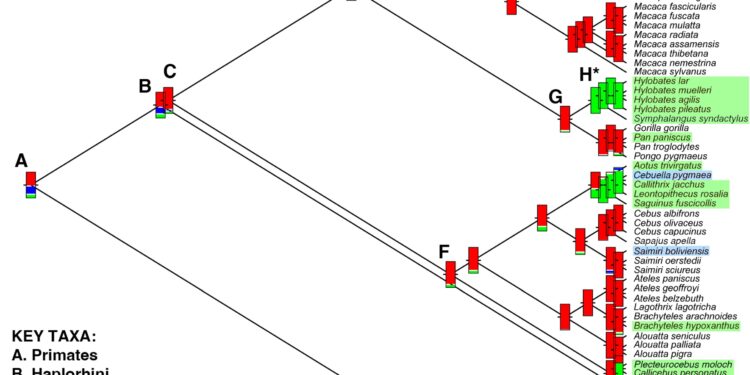Intersexual power is highly variable among primates. Colored boxes indicate the type of intersexual power reconstructed for ancestral nodes in the ASR analysis of discrete power categories. In each box, the width of the color band (red = dominant male, green = codominant, blue = dominant female) is proportional to the scaled probability of each power category occurring at the node. The character state of a clade’s last common ancestor (LCA) is unambiguous when the box is a solid color. Extant taxa with non-male-biased power are highlighted on the right (green = co-dominant, blue = dominant female). Key nodes are identified by capital letters. * identifies nodes with a scaled probability ≥ 0.95 that a single power category occurs at the node. Male-biased power is more likely in the Anthropoid LCA, while female-biased power is more likely in the Lemuriform LCA. Greater uncertainty exists for LCA of Primates, Strepsirrhini and Haplorhini. If the LCA of Anthropoidea exhibited male-biased power (scaled probability = 0.844), then the various anthropoid taxa that do not exhibit male-biased power are likely derived and document more than 7 transitions towards power that is not biased in favor of males. Credit: Animals (2023). DOI: 10.3390/ani13233695
Male dominance has long been considered near universal among primates, with female power seen as a rare exception to the rule. However, according to researchers at the University of Texas at Austin, female-friendly power structures or social equality between the sexes can be found within all major primate groups and have likely existed throughout history. history of evolution.
The study, published in the journal Animalschallenges assumptions of male dominance in primates and may also have implications for other animal species.
The team reviewed previous literature on 79 primate species, dividing them into male-dominant, female-dominant, or co-dominant categories, then analyzed the variables that correlated with these social patterns.
They found that male-biased power was likely to develop in species in which males had larger bodies and longer canines than their female counterparts. Female power may emerge when the supply of available female mates is lower than male demand, thus giving females of these species greater social leverage, particularly if size differences between the sexes are minimal.
“In the past, primatologists have often focused on the role of males and their power in primate societies,” said Rebecca Lewis, professor of anthropology and co-author of the paper. “What has sometimes been overlooked is the important role of female power in primate societies. Our work suggests that more economic forms of power may actually come to the fore in primate species in which males and females are of similar size and in which females are therefore larger. less easily constrained by males.
Among primates, female power structures are commonly seen in lemurs. Previous researchers have often attempted to explain this event as an anomaly resulting from unique environmental factors. However, the new study draws attention to the presence of equal, predominantly female power structures within many other primate species, such as gibbons in Southeast Asia and marmosets in the Americas.
Additionally, the study was able to estimate the likelihood of male-biased power in ancestral primate groups. The study found that no particular pattern of intersexual power can be attributed with certainty to the ancestors of many major primate groups and, therefore, the hypothesis of male-biased ancestral power is not justified.
“Primates are thought to be primarily dominant males, suggesting that male dominance was present in primates early in their evolutionary history,” said Chris Kirk, a UT anthropology professor and co-author. . “If this hypothesis is correct, then it would be necessary to explain the existence of predominantly female societies and societies where gender equality is greater.”
“However, we show that this hypothesis of male-dominated ancestral power in primates is not necessarily supported by the data. In fact, other types of intersexual power relationships are sufficiently common in primate societies so that it is not clear what the ancestral condition might have. Thus, all types of intersexual power need to be explained, not just the presence of female-biased power.
More information:
Rebecca J. Lewis et al, Evolutionary Models of Intersexual Power, Animals (2023). DOI: 10.3390/ani13233695
Provided by the University of Texas at Austin
Quote: Men’s power over women is not the default social dynamic among primates, study finds (January 18, 2024) retrieved January 18, 2024 from
This document is subject to copyright. Apart from fair use for private study or research purposes, no part may be reproduced without written permission. The content is provided for information only.



